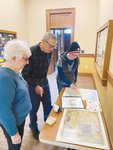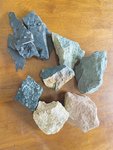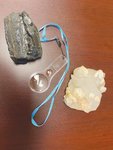


PITTSBORO — The Chatham County Historical Museum will soon allow visitors to see firsthand hundreds of millions of years’ worth of local history, predating the existence of human development inside county lines.
The museum is set to open a short-term exhibit in April to highlight the area’s geology and how it has affected the county’s history and development. Museum director Cindy Schmidt and exhibit director Wanda Pender enlisted retired geologist Chris Palmer to identify and map out the history of Chatham County’s geological resources.
Palmer will also lead two programs while the museum hosts the exhibit. The first program will take place on the first Sunday in April, where Palmer will identify rocks residents bring in and answer questions about the geology behind everyday life. The second program — which will take place on May 15 — will feature a presentation, plus a question-and-answer panel with Palmer, where he’ll discuss rocks, fossils and more he has found in Chatham County and their significance to documenting the area’s ancient history.
“The Chatham County Historical Association board wants to do between three and five programs a year, so I brought Chris’s name and the subject to the board, and they were very enthusiastic about making it one of our programs for the year,” Schmidt said.
Palmer came to Chatham County five years ago after retiring from researching seismic activity along the West coast, particularly around the San Andreas fault line in California.
After arriving in Chatham, Palmer and his wife decided to take a community college course involving a geology-centric field trip led by Phil Bradley, the Senior Piedmont Geologist for the North Carolina Geological Survey.
So, when Schmidt asked Palmer to help develop a geology museum exhibit, he asked for Bradley’s help, as well as for background information on Piedmont geology.
“He has done a lot of work around Chatham County,” Palmer said, “and he is actually getting ready to publish a geological map of the county.”
As Palmer began his research into the county, he soon learned Chatham’s history predates any settlers, or Native Americans who inhabited the land prior. Palmer found hundreds of millions of years’ worth of history, ranging from ancient fossils, minerals, evidence of drastic seismic activity such as earthquakes, and more.
“The area is underlain by a sequence of tectonic blocks and shoved together over the last 600 or 700 million years, and in Chatham, that has been going on for around 630 million years,” Palmer said. “Between Pangea and the formation of the Atlantic Ocean, there has been a lot that has been going on, which makes for interesting geology.”
One of the more interesting finds, according to Palmer, relates to the potential for earthquakes in Chatham, as well as around the state. He discovered evidence of ancient seismic activity, and learned more about the fault lines surrounding the state — such as one between Eastern Tennessee and Western North Carolina, as well as another in Central Virginia, which caused an earthquake which damaged the Washington monument in Washington, D.C.
“You can see those forces operating out west, and it is gigantic, while here, those forces were operating here, only it was hundreds of millions of years ago,” Palmer said. “I got to see the current activity out west, and then travel back to the past when I came here.”
According to Palmer, Chatham likely won’t experience any seismic activity like that in communities along the known fault lines, such as San Francisco or Los Angeles. Chatham, though, may lie close to a fault line geologists just don’t know about yet — though Palmer doubts it.
“There is some remobilization in the Appalachians,” he said, “and you won’t know there is a fault there until one snaps, like the one in Virginia.”
The exhibit will not only cover the area’s seismic history, but will showcase examples of the county’s natural resources, including highlighting the history of mining in Chatham.
Pender said a section of the exhibit will also be dedicated to the mines around the county, highlighting some of the tragedies surrounding these industries, including a mine explosion in 1925.
“One we will highlight is Ore Hill, which was used during the Revolutionary times to manufacture munitions, and another one would be Coal Glen Mine, which was the site of the huge explosion that killed 53 people,” Pender said. “It remained the largest disaster in the United States for many years.”
Palmer has created a detailed map out of county documents pinpointing all locations for current and past mine sites, Pender said. With this map, Pender hopes Chatham residents will be able to learn something new about the place they call home.
“Chris has been most gracious in working with me to try to get his information into exhibits in the museum that people can see over the next two months,” Pender said. “I think people will be surprised with just how many mines are in Chatham County, historical and ongoing.”
Schmidt hopes people will learn more about how geological resources can impact any given area’s economy.
An example of this in Chatham Schmidt gave relates to the high amounts of clay in the county’s southeast corner. Schmidt said the brick industry has taken advantage of those resources, and in turn, has helped to develop Chatham’s economy.
“What’s available from the soil and the ground has always brought a good economy to Chatham,” Schmidt said. “Rocks, soil and water can impact how Chatham has developed over the years, just because of what lays there.”
She hopes this exhibit provides Chatham residents a glimpse into how natural resources and the world around them shape their daily life, even if they can’t see it directly.
“People don’t quite have an awareness for how much their everyday lives are impacted by things that they can’t see, the things beneath their feet such as the soil, rocks, water and more,” she said. “It has a daily impact, and we just want people to explore the ecosystem beneath our feet, and how that ecosystem affects what is up and around us everyday.”
Reporter Taylor Heeden can be reached at theeden@chathamnr.com.